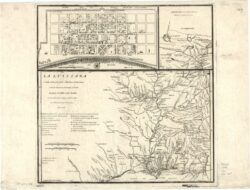Treaty of Fontainebleau
The Treaty of Fontainebleau ceded all the territory of French colonial Louisiana west of the Mississippi River, along with New Orleans, to Spain.

Library of Congress, Geography and Map Division
A map of the territory of Louisiana and New Orleans ceded by France to Spain during the Treaty of Fontainebleau.
In the Treaty of Fontainebleau, signed November 3, 1762, France ceded all the territory of colonial Louisiana west of the Mississippi River, along with New Orleans, to Spain. This secret treaty was made amid negotiations between Great Britain and the allied powers of France and Spain to end the Seven Years’ War (1756–1763). Together with the 1763 Treaty of Paris, which concluded the war, the Treaty of Fontainebleau reorganized colonial North America. To compensate Spain for joining the war effort and as incentive to accept the peace terms with Great Britain, France’s King Louis XV, offered western Louisiana and New Orleans to Spain’s King Carlos III. Under the terms of the Treaty of Paris, France gave up its territory in Canada and the eastern part of Louisiana to the British while Great Britain received Florida for returning the Cuban port of Havana to Spain. These treaties ended more than 150 years of French colonization in North America and divided the continent between Spain and Great Britain along the Mississippi. Louisiana became a Spanish colony and remained under Spanish rule for almost four decades.
The Seven Years’ War
The Seven Years’ War, also known as the French and Indian War, was the first war between European empires that began in the colonies and spread to Europe. American Indian and European allies aided the main adversaries, France and Great Britain. The conflict eventually grew into a global war with combat taking place in North America, the Caribbean, West Africa, Europe, India, and the Philippines. Colonial territories not only served as the setting for much of the fighting but also as prizes to be won and assets to be leveraged in alliance and peace negotiations.
The Family Compact
Louisiana played an important role in France’s diplomatic tactics between 1760 and 1762. After the British fully conquered Canada in 1760, the French sought military and financial assistance from Spain. Until the death of King Ferdinand VI in 1759, Spain had remained neutral in the conflict. Ferdinand’s successor proved more willing to support France against Great Britain. Carlos III was a member of the Bourbon family and cousin to France’s Louis XV. In August 1761 the two kingdoms formed an alliance known as the Family Compact. During alliance negotiations and after the compact was set, French Foreign Minister Étienne François de Stainville, duc de Choiseul used Louisiana as a bargaining chip. He hoped the offer of Louisiana would induce Spain to provide France with a large loan, enter the war immediately, or both. Spain showed interest in Louisiana but did not agree to Choiseul’s requests.
Peace Negotiations
Several developments in 1762 made Louisiana a valuable bargaining tool once again. In January Great Britain declared war on Spain. Within a few months France lost significant holdings in the Caribbean, including Martinique, Guadeloupe, and St. Lucia. Because these sugar-producing islands generated more wealth than Louisiana, France was willing to give up a portion of the territory to the British for their return. Choiseul began negotiating peace terms with British Minister John Stuart, Earl of Bute, in which he agreed to cede the portion of Louisiana east of the Mississippi to Great Britain. The British would also keep Canada while France would maintain fishing rights in Newfoundland and regain the Caribbean islands. Although New Orleans is located on the east side of the river, Choiseul managed to keep it out of British hands by assuring Bute that there was access to the Gulf of Mexico above the city through Lake Pontchartrain and Lake Maurepas.
Once a deal was worked out with Bute, Choiseul had the difficult task of convincing his Spanish counterpart, Jerónimo Grimaldi, Marquis de Grimaldi, to agree to it. The Spanish opposed a cession of French territory that allowed the British to control the coast along the Gulf of Mexico. Spain became even less willing to negotiate a peace settlement when news of the capture of Havana reached Europe. To persuade Spain to end the war, France offered its ally western Louisiana and New Orleans. The Spanish agreed, believing the territory would provide a buffer between the British colonies and Mexico’s mineral wealth.
Both the Treaty of Fontainebleau and the preliminary peace agreement that became the Treaty of Paris were signed on the same day at the French palace Château de Fontainebleau on November 3, 1762. Representatives of Great Britain, France, and Spain ratified the final version of the Treaty of Paris on February 10, 1763.
Spain Slowly Takes Command of Louisiana
Terms of the Treaty of Fontainebleau were not made public until 1764. Louisianans did not learn of their Spanish subjecthood until late spring of that year, and the first Spanish governor, Antonio de Ulloa, did not arrive in New Orleans until 1766. Upset over new trade regulations implemented by the Spanish, white Creole leaders ousted Ulloa during a 1768 insurrection. With the arrival of General Alejandro O’Reilly and two thousand troops in 1769, Spain fully took command of Louisiana and continued to govern the colony until 1803.
